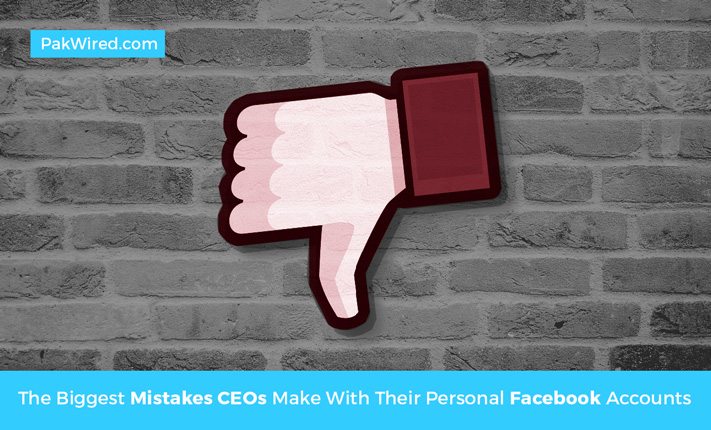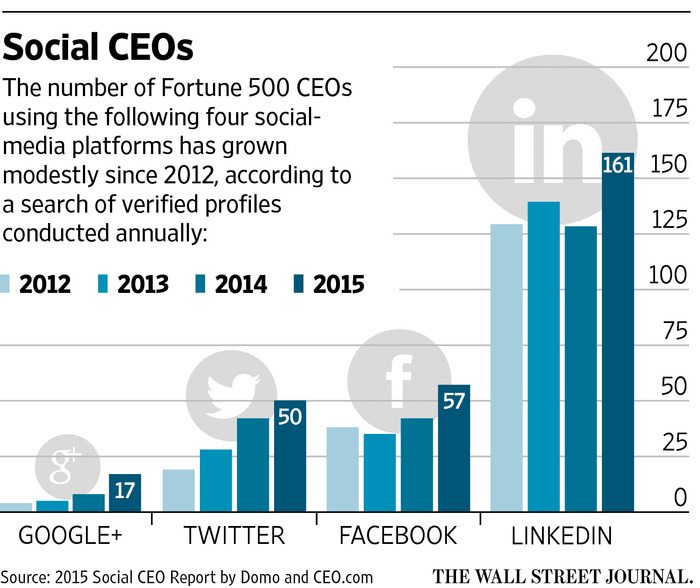Companies know that Facebook is the most important social network for reaching consumers. That’s because 73% of Americans use Facebook every day, compared with 27% who use Twitter that much and just 17% who look at LinkedIn every day, according to a recent survey by Springboard America, a market research provider.
For the same reason, Facebook is a crucial platform for the leaders of those companies: When social-media usage is so overwhelmingly skewed toward Facebook, CEOs can’t afford to limit their professional online presence to what some might consider the more serious networks of Twitter and LinkedIn.
However, CEOs can’t approach Facebook the way other professionals or even other managers do. As the public face of their companies, CEOs are subject to far greater scrutiny both internally and externally. That gives them unique opportunities on Facebook—but also distinctive risks.
Used properly, a CEO’s Facebook presence can support a company’s growth and provide a channel for engaging with employees, customers and the public. Used poorly, Facebook can hurt both a CEO’s effectiveness and the company as a whole. Here are seven mistakes every CEO needs to avoid.
1. Ignoring it. CEOs who don’t use Facebook are like CEOs who don’t watch TV: They’ve fallen into CEO World, that parallel dimension where leaders are disconnected from the way most people live, shop and connect. CEOs who aren’t on Facebook are out of touch with a significant part of their customers’ and employees’ lives. And a passive presence isn’t good enough. CEOs won’t get the most out of Facebook if they only lurk, posting rarely, or let their social-media team do all the work of maintaining their presence.
2. Letting it all hang out. Employees and customers don’t need to see a CEO’s political musings, latest luxury car or family photos, especially if they were taken on a yacht purchased with a year-end bonus. That’s why it’s essential for CEOs to use Facebook lists to target any personal posts to a narrow set of people they know personally. But even then they need to be careful: As public figures, CEOs need to use Facebook as if every single thing they post (including comments on their friends’ posts) could be on the front page of tomorrow’s paper. The bigger the company, or the more prominent the CEO’s personal profile, the more likely it is that some enterprising journalist or blogger will go digging for their next scoop. But that shouldn’t mean shying away from reaching out on Facebook. On the contrary, by posting publicly, CEOs have the opportunity to speak directly to customers and employees, and to convey key news or insights in their own voice, and in a context that will help customers feel more connected to the company.
3. Buttoning it down. It’s also crucial that a CEO doesn’t come off like a stiff. A CEO’s Facebook presence needs to be updated at least once a week (more—even a lot more, like several times a day—is fine as long as the posts offer real value or insight). And it should have a human voice, not a corporate one. While the majority of posts can be business-related, it’s good to include some personal news, too, because that makes both a CEO and the company she leads seem more approachable. A good way to accomplish that is by identifying two or three personal interests that the CEO can occasionally post about, like a favorite band, sports team, charity or book. A bad way is to share content that feels entirely frivolous or distracting; kitten videos or photos of every single meal will make people wonder about the CEO’s time management and priorities.
4. Invading employees’ privacy. Just because a CEO can’t treat Facebook as a private space doesn’t mean the same holds true for all employees. For a great many people, Facebook is about staying in touch with their friends and family, and they don’t want to feel like the boss is staring over their shoulder. CEOs shouldn’t send friend requests to employees—but should accept any internal friend requests that come their way. In general, a CEO should be cautious about commenting on employees’ Facebook posts, too, even if they’re public—unless an employee specifically tags their CEO in a Facebook post, which is an invitation to comment.
5. Doing it all alone. While a corporate social-media team can’t be expected to support the Facebook presences of regular employees, it’s essential to involve them in a CEO’s presence. How they’re involved is equally crucial: Smart social-media teams avoid corporatizing the CEO’s voice and instead simply ensure that a CEO’s posts are aligned with the company’s overall brand and social-media strategy. A social-media team can also provide advice and support in maintaining the CEO’s presence, and may even give the CEO links to share, or draft posts. In the best-case scenario, the social team provides both content support and a reality check on a CEO’s posts, making sure the CEO sounds neither uberprivileged nor unbelievably Joe Average. It’s essential that CEOs personally review every post, however, and ensure it sounds like their personal, authentic voice.
6. Creating multiple profiles. Some professionals manage their Facebook lives by having separate profiles. But that’s actually in contravention of Facebook’s terms of service—a technicality, perhaps, but one that it isn’t good for CEOs to be seen flouting. Multiple profiles also create the risk of sharing to the wrong account. It’s better for CEOs to have one judiciously managed profile with lists that target different content to different audiences.
7. Missing out on intel. Facebook can be an easy way for CEOs to gather feedback from friends and customers on emerging business trends and opportunities. While CEOs should avoid asking for input on hot-button issues or ideas they can’t deliver on, they can build their understanding of customers by asking open-ended questions like “What do you think is going to be the biggest trend in our industry this year?” or “What’s the best customer experience you had this month?” Asking for input is also a great way of helping employees and customers feel closer to the company; for example, asking which charity the CEO should raise money for in a coming marathon run. By not only asking for input but also following up with updates on how that input affected thinking or decision-making, a CEO can build a reputation for transparency and responsiveness.
By avoiding these quintessential Facebook mistakes, CEOs don’t just sidestep the risks that Facebook can pose. They position themselves to tap into Facebook as a driver of customer insight, employee trust and business growth.
This post was originally published on: WSJ.



